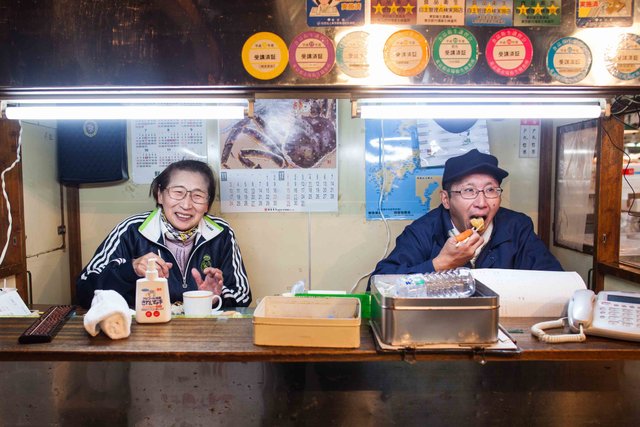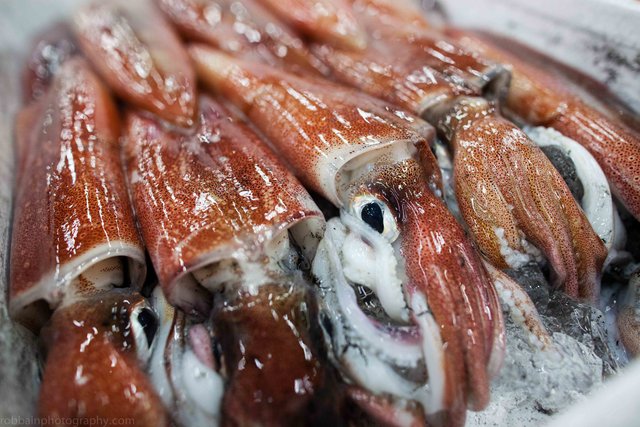TSUKIJI'S LAST WORKERS
FEATURE Nº2

FINAL CHAPTER FOR WORKERS AT THE WORLD'S LARGEST FISH MARKET AND EIGHT DECADES OF JAPANESE HISTORY.
Words by Fraser Morton & photography by Rob Bain
Chiyoko Tomaru’s voice cracks with emotion as she says the Tsukiji Fish Market has been her life for 50 years. It’s where her husband worked when they met. And when he died in 1973, Chiyoko took over the modest sushi stall. Her son now works with her. The market is her life.
In February 2017 the world’s largest fish market will be moved from its prime location in downtown Tokyo 2.3 kilometers away to a state-of-art US$3.8 billion facility in what is hoped will breathe new life into an aging business.
But when the shutters are finally sealed at Tsukiji, for many of the workers a chapter of Japanese history will end too.
“I will move. I have to work,” 77-year-old Chiyoko says as she fights back tears.
“And I will bring my husband’s memory with me. But I’ve been here for so long. It’s been one of the toughest decisions of my life,” she says.

Chiyoko Tomaru enjoys a meal with a friend at the Tsukiji Fish Market.
A tourism icon
More than 2,000 tonnes and USD18 million dollars of fish changes hands every day at Tsukiji – so named after the 50-acre area of prime real estate the market occupies near the city centre.
From dawn each morning a steady stream of tourists amble along the market’s narrow gangways gawking at workers as they haggle over prices and carve up the day’s catch while men driving motorized carts loaded with containers of fish zigzag through the labyrinth of flooded aisles. Hundreds of thousands of tourists come here each year. They come for a slice of history that will soon be repackaged and relocated south to a site overlooking Tokyo Bay.

Ishizuka Toshiaki
“I think fewer tourists will visit the new market,” says one of Tsukiji’s longest-serving workers, Ishizuka Toshiaki.
The 78-year-old has been hawking fish here for 63 years. He works outside the market, known as the jogai shijo. Here there is a mix of wholesale and retail stalls selling all manner of goods, from samurai swords to exorbitantly priced melon and prime cuts of wagyu beef. About 400 restaurants are also peppered throughout the jogai shijo.
“It’s the history tourists come for and even though the new market will be more modern, it can’t replace the way we have worked here for so long,” Ishizuka says, “I don’t want to move. I love this place, and I’m used to the way we do things here.”

Naofumi Yamashita

Time for change
Tsukiji opened its doors 1935, twelve years after the city’s main fish market in Nihonbashi was decimated by the Great Kanto Earthquake. Aside from the means of transportation – from rail to trucks – little has changed for many of the workers over eight decades at Tsukiji. Some say change is needed.
Naofumi Yamashita, 53, is part of the old guard. Thirty-three years of his life are bound to the market.
“I won’t miss it,” he says, as he sloshes through an inch of water, scrawling on his clipboard as he makes his rounds, selecting fish that he will send to brokers all over Japan.
“It’s too old and too small. The new market will help us control the temperature better. With the heat in the summer months in Tokyo we need to ensure hygiene,” he says.


It’s this view that proponents of the new market are trying to sell, and a step away from the “old and dirty” image of Tsukiji, in the words of one former Tokyo governor.
The new site, which will be 40 per cent larger than Tsukiji, comes with its share of problems. The area in Toyosu was formerly home to a gas plant that has caused widespread contamination, with more than half-a-billion dollars of taxpayer money being pumped into a massive clean-up operation. The new market was slated to open November 7, but contamination woes have bumped it over to next year.
Yoshimasa Masuda, 63, who owns a small sushi restaurant at Tsukiji, says the new market will be more fun for visitors.
“At the new market the tourists can’t get in the way of the workers. There will only be certain areas they can go and it will be safer for everyone,” he says. “Also, I’ve heard there will viewing decks and observatories where tourists can see the traders bid for tuna.”
There have been problems for years concerning visitors to Tsukiji. They are currently banned entrance to the tuna auctions due some unruly visitors disrupting the fast-paced auctions, where bidders use a sign-language system harking back to a model used decades ago by stock brokers.

Fukuhara Tsudoi
“Some tourists still get in the way of our work,” says Fukuhara Tsudoi, 51, who has been selling sushi taman at the market for more than two decades.
“This is not a tourist attraction it’s a place of work and we have problems with some people who don’t follow the rules and routes and who are rude,” she says.


End of an era
Change has been coming for a long time. The relocation was first flaunted 15 years ago, which was quickly met with widespread opposition and protests with many of the brokers fearing their roles would become obsolete due to corporate wholesalers muscling in at the new site. Then there was the contamination issue at the Toyosu that sparked further protests.
Many of the Tsukiji stalwarts are still vocally against the move, but the reality is clear. The market will close. Plans are afoot to keep the jogai shijo restaurants and stalls at the current site, but without the market many hold out little hope for their survival. The city plans to use the majority of the real estate to build a tunnel linking downtown venues for the 2020 Olympic Games and a large swath is earmarked for an upmarket housing complex.
Despite the move some workers hold out little hope the new market can replicate the boom years of Tsukiji.
Kubaiashi Yasuteru, 52, moved from Yokohama 30 years ago to come work at the market. He plies his trade as a seller at the jogai shijo. He says the amount of fish being sold has been on a steady decline. From six million tonnes caught in 1995 to 3.8 million in 2011 the decline of resources is due to numerous reasons – overfishing, climate change and, of course, the earthquake and tsunami of the same year which affected tourism and fish resources flooding into the market. While officials say the new site can generate 10 to 20 per cent more sales, Kubaiashi has seen the industry take a plunge during his time.
“The fishing industry in Japan will continue its decline as a whole. It’s supermarkets today that are the biggest customer for us. That’s changed from restaurants as young people today aren’t eating as much fish,” he says.
His view is echoed by Aoki Koichi, 68, who after retiring eight years ago took a job at Tsukiji to supply pricing information to Japanese media outlets.
“We will miss the market. It’s part of our history and our culture, and we sold a lot of fish here, but it’s never going to be as big as it was,” he says, as he trudges off on his rounds of the market, his rubber boots squelching in the slop on the floor as he goes about his business in a place that will soon be lost to Japanese history.






